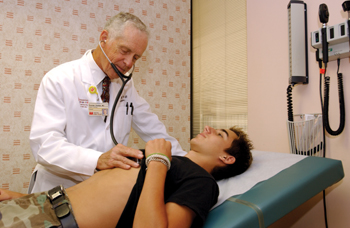
Thomas Graham, M.D., examines long-time patient Keith Couth, 16, of Columbia, Tenn. Graham is retiring after 33 years at Vanderbilt. Photo by Anne Rayner
Thomas Graham retires after 33 years of service
After 33 years of building on his passion for children and cardiology, Thomas Graham, M.D., has officially stepped down as the chief of the division of Pediatric Cardiology at Vanderbilt Children’s Hospital.
Graham is already knee-deep in plans to devote more time to the other loves of his life: his family and travel adventures.
As of July 1, Graham reduced his clinic hours by half. He now sees his pediatric cardiology patients at the clinic two days a week and soon that clinic will move to the Doctors Office Tower at the Monroe Carell Jr. Children’s Hospital at Vanderbilt.
The move to semi-retirement has been a plan long in the making. Graham’s love for family and travel are quickly apparent when you walk into Graham’s office on the second floor of Medical Center North.
At first all you can see is the poster-sized photograph hung right above it. The image is 13 years old and features Graham and his wife, Carol Ann, their son, daughter-in-law and two daughters, standing before a snowy mountain vista in Yellowstone National Park.
Now that the children are grown with families of their own, the Grahams want to see more of the five grandchildren (and one on the way this December). But hiking and adventure trips that have called Graham for years are already pulling him from his office more than ever before. He was even on a trip the day his tenure as division chief ended.
“On July1, I was in the Canadian Rockies, on the longest hike of our trip there. We were on a mountain, getting ready to go back down to the Emerald Lodge for dinner,” Graham smiled. “We toasted my retirement overlooking Emerald Lake.”
Graham nearly came to Vanderbilt as his first job after his fellowship at Duke.
“I was invited to come here by Dr. David Karzon. It was 1969 and I was on my way to Nashville, in the air in fact, when Neil Armstrong set foot on the moon,” Graham said. “I had to see it on re-runs.”
But the trip wasn’t enticing enough to get Graham to come, yet. He worked at Duke for a couple of years before officially accepting Karzon’s invitation in 1971.
He brought with him a colleague from Duke, Gerry Atwood, M.D., and began developing Pediatric Cardiology at VCH.
“We had only a handful of useful drugs when I began, and now we have 20 or more for the patients we see. In addition, major advances in surgery and interventional catheterization have made this specialty particularly rewarding,” said Graham.
Graham has seen the practice of cardiology in children grow from a small specialty with just a few tricks in its bag, to a full and vibrant practice where doctors can fix nearly any congenital heart defect… not perfectly, he says, but close.
A favorite example is development of a surgery for babies born with a single ventricle, or an especially small ventricle, called hypoplastic left heart syndrome.
“There wasn’t much we could do for children born with a single ventricle until the Fontan operation was developed in the early 70s. This was a major advance,” Graham said. “Then when the Norwood operation was developed in the 1980s we were able to get very sick infants with hypoplastic left heart syndrome to a size and age when the Fontan procedure could be applied to them also. Now these children can survive and look forward to an active and productive life.”
He remembers the excitement of witnessing what a new drug could do to stabilize so-called “blue babies” enough for them to make it into surgery to repair transposition of the great arteries.
“In the cath lab we prepared to give a baby the new drug prostaglandin, meant to keep a fetal pathway for blood in the heart, called the ductus arteriosis, open. We drew a vial of blood before we infused the drug and the blood was dark blue, almost black,” said Graham. “Five minutes later after we gave the drug it turned bright red with oxygen. I’ll never forget that.”
The pure joy of seeing children, who would certainly have died, live, because of new developments in his field, has kept Graham pushing for more for three decades. He wants to see the push continue long after he is gone.
“Genetic treatments will be important. We need more information on pulmonary vascular disease like pulmonary hypertension,”Graham said. “And patients with congenital heart defects that have been fixed need continuing care into adulthood. It’s a whole new area that Dr. Ben Byrd is working to develop.”
Graham is proud of having built a division that has trained more than 30 pediatric cardiologists to carry on the work. He has been known as a problem solver, a dependable and brilliant physician and administrator. He stepped in twice as the interim chairman of the department of Pediatrics between the tenures of Karzon and Ian Burr, M.D. and then again between Ian Burr and Arnold Strauss, M.D., the current chairman. He considers himself a builder. Now he feels he is ready to let someone else carry on the building project.
“We have wonderful people here in the division,” Graham said. “I know it’s in really good hands. It’s also an exciting career,” said Graham. “I hope more young people go into pediatric cardiology. There is much more to be done.”













